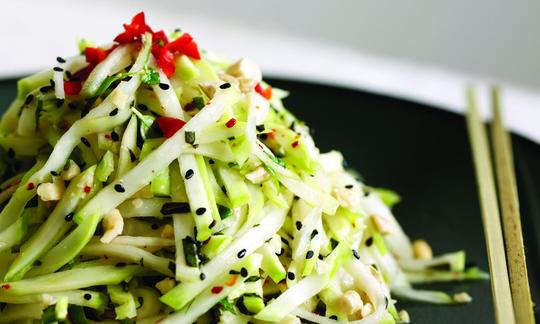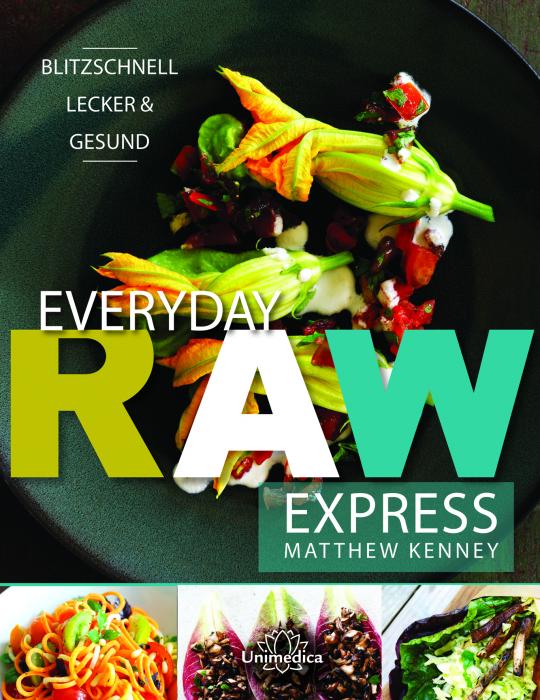Thai Salad with Kohlrabi, Cilantro, and Mint
vegan
Ingredients (for servings, )
| For the Thai dressing | |
|---|---|
| 1 oz | Cashew nuts, raw? organic? (cashew nuts) |
| 80 ml | Sesame oil, raw? organic? (2.6 oz) |
| 60 ml | Reduced salt soy sauce (Genen-Shoyu, organic?, raw?) (2.4 oz) |
| 2 ⅛ oz | Rapeseed oil (canola, HOLL oil, kernel oil), cold pressed?, organic? |
| 60 ml | Lemon juice (raw?, organic?) (2.2 oz) |
| 2 tbsp | Agave syrup (agave syrup, raw?, organic?) (0.82 oz) |
| 2 tbsp | Drinking water, raw (organic?) (0.40 oz) |
| 1 | Chili peppers, sun-dried (raw?, organic?) (0.02 oz) |
| 1 dash | Table salt (table salt, raw?, organic?) (0.01 oz) |
| 1 dash | Black pepper (organic?, raw?) (0.00 oz) |
| For the salad | |
| 4 | Kohlrabi, raw (organic?) (49 oz) |
| 2 sprigs | Coriander leaves, raw (0.16 oz) |
| 15 leaves | Green mint, raw (organic?) (0.08 oz) |
| 3 tbsp | Cashew nuts, raw? organic? (cashew nuts) (0.88 oz) |
Equipment
- blender or hand-held blender / immersion blender
- grater
- citrus juicer (lemon squeezer)
Type of preparation
- chop or grind
- food preparation without heating
- soak
- blend
- squeeze
- season to taste
Preparation
For the Thai dressing
Soak the cashews for about 20 minutes.In most cases, it is recommended that you soak cashews for at least 2-3 hours. As Matthew Kenney lists 10 minutes preparation time for this recipe, we assume that 20 minutes soaking time will be long enough. Since cashews are relatively soft, they will blend well even with the shortened soaking time.
For the dressing, blend all of the ingredients in a blender until smooth. Season with salt and pepper.
Chili flakes are basically dried, crushed chili peppers. It is best to prepare the chili with a knife without touching the flakes because the spicy capsaicin adheres to your hands and can cause painful burning if it comes in contact with mucous membranes, for example, your eyes.
For the salad
Grate the kohlrabi, chop the cilantro and mint, and mix everything together.The author uses a small handful of both mint and cilantro. We have provided a rough estimate, which you can adjust as you like.
Drizzle the dressing generously on the salad and, if desired, season with salt, pepper, and chili flakes. Garnish with a little chopped mint and chopped cashews and serve.
|
Nutritional Information per person
Convert per 100g
|
2000 kcal | |
|---|---|---|
| Energy | 337 kcal | 16.8% |
| Fat/Lipids | 27 g | 38.0% |
| Saturated Fats | 3.2 g | 16.2% |
| Carbohydrates (inc.dietary fiber) | 22 g | 8.1% |
| Sugars | 10.0 g | 11.1% |
| Fiber | 8.8 g | 35.4% |
| Protein/Albumin | 6.7 g | 13.4% |
| Cooking Salt (Na:433.3 mg) | 1'100 mg | 45.9% |
| Essential micronutrients with the highest proportions | per person | 2000 kcal | |
|---|---|---|---|
| Vit | Vitamin C (ascorbic acid) | 150 mg | 188.0% |
| Fat | Linoleic acid; LA; 18:2 omega-6 | 7.7 g | 77.0% |
| Sodium, Na | 433 mg | 54.0% | |
| Min | Copper, Cu | 0.51 mg | 51.0% |
| Fat | Alpha-Linolenic acid; ALA; 18:3 omega-3 | 1.0 g | 51.0% |
| Elem | Potassium, K | 898 mg | 45.0% |
| Vit | Vitamin B6 (pyridoxine) | 0.41 mg | 29.0% |
| Vit | Vitamin E, as a-TEs | 3.2 mg | 27.0% |
| Min | Manganese, Mn | 0.49 mg | 24.0% |
| Elem | Phosphorus, P | 164 mg | 23.0% |
Detailed Nutritional Information per Person for this Recipe
The majority of the nutritional information comes from the USDA (US Department of Agriculture). This means that the information for natural products is often incomplete or only given within broader categories, whereas in most cases products made from these have more complete information displayed.
If we take flaxseed, for example, the important essential amino acid ALA (omega-3) is only included in an overarching category whereas for flaxseed oil ALA is listed specifically. In time, we will be able to change this, but it will require a lot of work. An “i” appears behind ingredients that have been adjusted and an explanation appears when you hover over this symbol.
For Erb Muesli, the original calculations resulted in 48 % of the daily requirement of ALA — but with the correction, we see that the muesli actually covers >100 % of the necessary recommendation for the omega-3 fatty acid ALA. Our goal is to eventually be able to compare the nutritional value of our recipes with those that are used in conventional western lifestyles.
| Essential fatty acids | per person | 2000 kcal |
|---|---|---|
| Linoleic acid; LA; 18:2 omega-6 | 7.7 g | 77.0% |
| Alpha-Linolenic acid; ALA; 18:3 omega-3 | 1.0 g | 51.0% |
| Essential amino acids | per person | 2000 kcal |
|---|---|---|
| Isoleucine (Ile, I) | 0.26 g | 21.0% |
| Tryptophan (Trp, W) | 0.05 g | 20.0% |
| Threonine (Thr, T, irreversibly transaminated) | 0.18 g | 19.0% |
| Valin (Val, V) | 0.22 g | 14.0% |
| Leucine (Leu, L) | 0.29 g | 12.0% |
| Lysine (Lys, K, irreversibly transaminated) | 0.22 g | 12.0% |
| Phenylalanine (Phe, F) | 0.18 g | 12.0% |
| Methionine (Met, M) | 0.06 g | 7.0% |
| Vitamins | per person | 2000 kcal |
|---|---|---|
| Vitamin C (ascorbic acid) | 150 mg | 188.0% |
| Vitamin B6 (pyridoxine) | 0.41 mg | 29.0% |
| Vitamin E, as a-TEs | 3.2 mg | 27.0% |
| Vitamin B9, B11 (Folate, as the active form of folic acid) | 44 µg | 22.0% |
| Vitamin K | 15 µg | 21.0% |
| Vitamin B1 (Thiamine) | 0.16 mg | 15.0% |
| Vitamin A, as RAE | 69 µg | 9.0% |
| Vitamin B5 (Pantothenic acid) | 0.48 mg | 8.0% |
| Vitamin B3 (Niacin) | 1.1 mg | 7.0% |
| Vitamin B2 (Riboflavin) | 0.06 mg | 5.0% |
| Vitamin B7 (Biotin, ex vitamin H) | 1.0 µg | 2.0% |
| Essential macroelements (macronutrients) | per person | 2000 kcal |
|---|---|---|
| Sodium, Na | 433 mg | 54.0% |
| Potassium, K | 898 mg | 45.0% |
| Phosphorus, P | 164 mg | 23.0% |
| Magnesium, Mg | 72 mg | 19.0% |
| Calcium, Ca | 62 mg | 8.0% |
| Essential trace elements (micronutrients) | per person | 2000 kcal |
|---|---|---|
| Copper, Cu | 0.51 mg | 51.0% |
| Manganese, Mn | 0.49 mg | 24.0% |
| Iron, Fe | 1.6 mg | 12.0% |
| Zinc, Zn | 0.62 mg | 6.0% |
| Selenium, Se | 3.6 µg | 6.0% |
| Fluorine, F | 1.4 µg | < 0.1% |
| Iod, I (Jod, J) | 0.46 µg | < 0.1% |
Narayana Verlag GmbH /Unimedica Verlag , Matthew Kenney
Raw recipes 90 (2), Cooked recipes (1)
Additional photos (6)
The book "Everyday Raw Express" by Matthew Kenney shows us how to quickly prepare healthy, varied raw food dishes.
Since this book is written in German, a description is omitted here. If you are interested, please switch to German in the menu.
This Thai salad is an ideal hors d’oeuvre on warm, summer days. The spiciness of the chili and sour taste of the lemon juice mixes well with the sweet kohlrabi.
Servings: This dish makes enough for 4–6 people, depending on whether it is used as a main meal or an appetizer.
We don’t consider soy sauce to be raw. Soybeans are generally heated during the production process since they like all other green beans contain the glycoprotein phasin, which is toxic for humans. Phasin inhibits the absorption of nutrients in the intestine, causes hemagglutination (clumping of the red blood cells), and in larger amounts can destroy the intestinal villi. Heating processes (e.g., cooking and roasting) destroy phasin, making soybeans and soybean products such as tofu, miso, and tempeh safe for human consumption. As a result, even unpasteurized soy products are not actually raw, but are instead cooked products that have been “revived” through the process of fermentation.
Cashews are seldom raw: Cashews almost always undergo a heating process even if “Raw Cashews” is listed on the label. This usually just means that the toxic cardol they contain has been deactivated by steaming instead of roasting. It is only when the process is explained in detail and controlled that we can be sure the cashews are raw.
Salt content: The high salt content is mainly a result of the soy sauce. The amount of salt listed here can be reduced by using a more moderate amount of the Thai dressing.
Spicy variation: This Thai salad tastes especially good when you use a larger amount of chili so that it is spicier.
Kohlrabi substitute: If you don’t have any kohlrabi on hand, you can instead use a root vegetable or a combination, such as beets, carrots, and jicama.
Sesame seeds: Adding sesame seeds as a garnish not only makes the dish look nice, it also gives this salad a slightly nutty taste.
Lime juice: Using lime juice instead of lemon juice makes the Thai dressing taste more authentic. Limes have a more intense flavor than lemons and generally a higher juice content.




